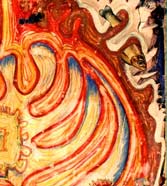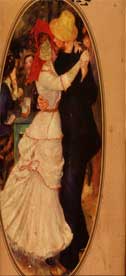
REVIEW OFHAUNTED WOMB
ENGLISH TRANSLATION
OF THE ORIGINAL FRENCH TRANSCRIPT
By STÉFAN CÉDILOT
The speakers are identified by the letters A through D, in order of appearance. D is French-Canadian writer and intellectual Dany Laferrière.
A.
There are strange things happening in this haunted womb.
B.
Yes, that [music] was from Haunted Womb, by Tomomi Morimoto, Maya Kuroki, Patrick Graham and Joshua Lamb. It is presented at Festival Accès Asie, which is the longest running Asian Heritage festival in Canada, it has been fourteen years, this is the 14th edition. So, first off, we penetrate into the venue through a long dark opaque corridor. It’s really dark in there.
A.
The word penetrate has been chosen with…
C.
(Laughs.) That’s good.
B.
… with parcimony. And we follow faint phosphorescent marks on the floor, we are obviously entering the womb, and we end up in the bedroom of a young Japanese girl who, while we get to our seats, is cutting images out of magazines. […] This lasts for about ten minutes after we arrive in the venue. She is the main character of the performance, played by choreographer and dancer Tomomi Morimoto, assisted by guitarist, singer, dancer and actress Maya Kuroki and percussionist Patrick Graham.
[He reads the press release.]
How does that translate into reality? Well… I did not understand everything, but I can still describe it. It is a performance that mixes modern dance, elements of butô (bu means dancing, tô means hitting the ground), cheerleading style dance (there is also some of that), it is very acrobatic, sometimes sensual, there are sumo poses, childlike dances (which are very funny, by the way), hand games (there is a choreography for four hands), mime, yes!
C.
(Laughs.) There is no escape!
B.
There is mime. So, dance, mixed with projected images, texts of poems appearing behind the musicians, there are installations, there is theatre, there is experimental 70’s Japanese pop music, and there is also comedy in this show, and there is [radio traffic reporter] Yves Desautels.
C.
(Laughs.) What?
B.
There is a moment when we hear Yves Desautels doing the traffic, telling us that Highway 20 is blocked. Look, what Yves Desautels was doing in a Japanese play, I had no idea!
A.
(Laughs.) Does he know about it?
B.
I met him yesterday and congratulated him for his performance in Haunted Womb,he was a bit surprised! (Laughs.) That’s the least we can say. He said: « What are you talking about? » So I explained that he was part of a performance at Festival Accès Asie. He said : « But, nobody ever told me about this », so I think Yves Desautels is talking to his lawyer.
(Laughs.)
It is a slightly destabilizing, but intriguing, artistic object. I thought it was well acted, well done, 60 minutes without intermission, which is perfect, not too long, not too short.
C.
For you.
B.
For me, and the people around me.
A.
Dany, who was there also, is watching us in amazement.
B.
Go ahead, Dany.
D.
I must say, the title, Haunted Womb, did not really work for me, this kind of title always scares me. There is this dark, opaque, sort of corridor that we have to go through and that announces a possible interaction with the actors. I do not like theatre, dance, or anything where I am asked to participate. When I entered, I saw this young woman, this young Japanese girl, sitting and cutting… it seemed like one of those Saturday evenings when teenagers anywhere in the world are bored, waiting to maybe go out later that night… I immediately felt a connexion. It is everything I like. What I saw, and happily I did not read the press release, which reminds me of Bouddhism…
B.
I read it after seeing the show.
D.
… what I saw has an extremely modern atmosphere, that has nothing Geisha about it, that has nothing to do with commercial Japanese culture, and which features a young girl, […] solidly grounded on solid legs, […] a very good dancer, there is nothing pretentious about the show, and, something rare in dance, there is a sort of narrative. You really feel that there is some form of boredom trying to take over, but that it will be shaken up by some fantasy that is in the character’s mind. So this young girl, who is bored, in her room, in Tokyo, has music in her head. And this music is played live. It is on stage, in the background, on a small stage, […] it resembles those small cubes we sometimes see and that give us something of an idea of Japanese apartments, that look like little cages, everything is minuscule, everything is encaged, and then there is that atmosphere of karaoke, a little bit of Dada, and music. […]
A.
It touched the Japanese writer in you?
(Laughs.)
D. (not laughing, very serious)
No, not at all. […] I think the word that defines this show is delightful.
[…]
D.
There is something delightful, in the sense that they work on every detail, everything is in a bubble. This show gives us the impression (by the way, we also see soap bubbles) of being somewhere between dream and reality, as if this young girl was waiting to go out, was not yet in the right mood, but something will happen, we don’t know what, and it’s only at the very end, when she puts on her costume, her overcoat…
B.
It is a dress, yes, and her high heel shoes, and she leaves…
D.
… we get the impression that she will leave, that she will go out to the party. For those who really love modern Japanese atmospheres, it is a must see, because it is delightful!






